-
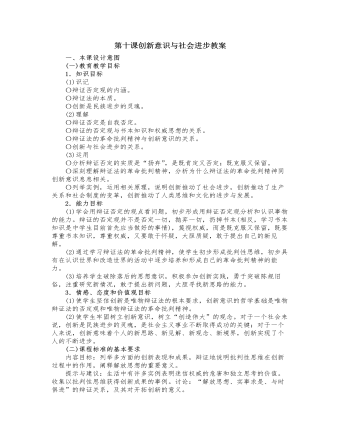
人教版高中政治必修4第十课创新意识与社会进步教案
2.辩证的否定(1)辩证的否定是事物的自我否定。事物内部存在着肯定方面和否定方面,它们既对立又统一。最初,肯定方面处于支配地位,否定方面处于被支配地位。在这种情况下,事物就被肯定着。但是,在矛盾双方的斗争中,否定方面总会由弱变强。一旦否定方面由被支配地位上升为支配地位,事物就转化到了自己的对立面,实现了对事物的否定。事物最终之所以被否定,根源在于事物的内部,是事物内部的否定因素战胜了肯定因素。因此,事物的否定是自我否定。(2)辩证的否定是事物发展的环节和联系的环节。所谓发展,是指新事物的产生和旧事物的灭亡。而实现这一过程必须要对旧事物进行否定,否定实现了事物由旧质向新质的飞跃。新事物在否定旧事物时,并不是把旧事物全盘抛弃,一笔勾销。旧事物是新事物的母体,新事物从旧事物那里脱胎而来,新事物是在批判地继承旧事物中的一切积极的有生命力的因素的基础上发展起来的。这样,在新旧事物之间就存在着必然的联系。
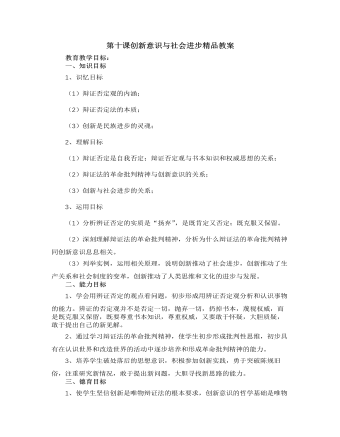
人教版高中政治必修4第十课创新意识与社会进步精品教案
在数学上,0这个数是解决记数和进位问题而引进的概念,由于它不能表示实在的东西,很长时间人们不把它看作是一个数。认为0是无,是对有的否定。从唯物辩证法的观点看,这种否定不是形而上学的简单否定,而是具有丰富内容的辨证否定。辨证的否定是发展的环节。0是从无到有的必经之路,是连接无和有的桥梁。0又是正数和负数之间的界限,它既否定了任何正数,也否定了任何负数,是唯一的中性数。但它又是联结正数和负数的中间环节。没有0,负数就过渡不到正数去,正数也休想发展到负数来。数学中的0是对任何定量的否定。如果没有这一否定,任何量的发展都无从谈起。这个否定不是一笔勾销,而是扬弃。因为它克服了任何定量的有限性,成为其发展的环节。在现实生活中,0作为辨证的否定,也体现出联系和发展的性质。如0度不是没有温度,而是非常确定的温度。
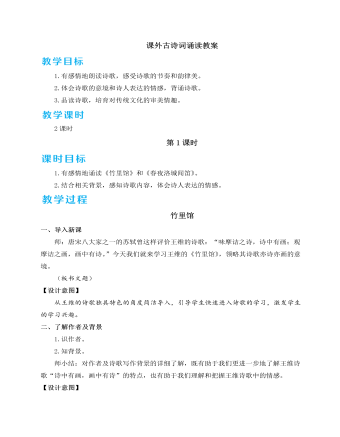
人教部编版七年级下册课外古诗词诵读教案
四、品读揣摩诗歌情志1.读出意境画面。师:请同学们以小组为单位,齐声朗读诗歌,然后合作交流,探究下面问题。(1)诗人用了哪些意象来表现晚春景色?诗人用了什么手法来写晚春景物?取得了怎样的艺术效果?(2)诗歌一、二句写出了怎样的晚春景致?请同学们用自己的语言描绘出来。(3)诗的三、四句意蕴深刻,为历代传诵。请从修辞手法的角度对这两句诗进行赏析。(生齐读后,小组交流、讨论问题,师指导明确)预设 (1)诗人用了草树、杨花、榆荚等意象表现晚春景色。一个“斗”字,运用拟人的修辞手法,把花朵人格化,形象生动地写出了晚春时节花草树木争芳斗艳的美丽景象。花草树木仿佛都有了情思,有了个性,成了精灵,使描绘的晚春景致生动而有情趣。
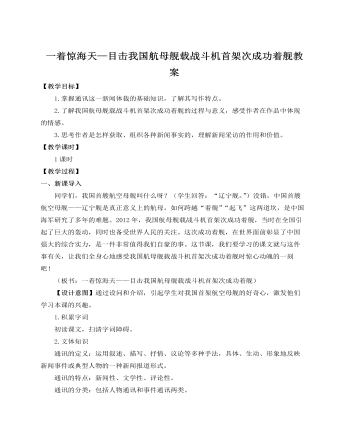
人教部编版语文八年级上册一着惊海天—目击我国航母舰载战斗机首架次成功着舰教案
2012年9月25日被称作辽宁舰的中国航母,是在苏联时期乌克兰黑海造船厂建造的“库兹涅佐夫元帅级”航空母舰次舰“瓦良格”号的基础上续建的。1991年12月苏联解体时,该航母已完工约70%,后来由于种种原因,俄罗斯海军取消了订单,这艘即将完工的航母被迫停产,随之报废。1998年4月,澳门创律旅游娱乐公司通过竞标,以2000万美元买下几乎拆成空壳子的“瓦良格”号航母。2005年4月“瓦良格”进入大连造船厂,由政府接管。此时的“瓦良格”只是一个锈迹斑斑的钢铁空壳,所有武器、电子系统均已被拆除或者破坏。中国海军准备在“瓦良格”的原型上进行续建,俄罗斯却不肯出让阻拦索技术,中国只能自行研制。所以,辽宁舰的改造经历了怎样的艰难历程,漫长的科技攻关之路遇到的重重障碍就可想而知了。疑难突破作为一篇新闻作品,本文是如何打动读者的?通过反复渲染、蓄势,营造训练现场的氛围,让读者透过文字感受从期待到紧张到彻底释放的心理过程,从而受到情感上的冲击。
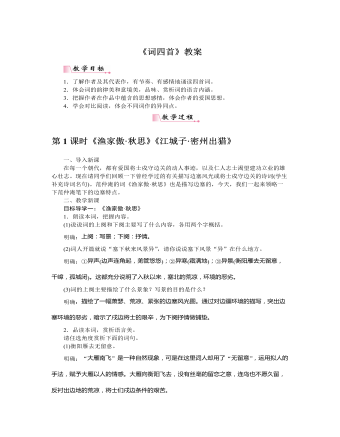
部编版语文九年级下册《词四首》教案
二、教学新课目标导学一:《破阵子·为陈同甫赋壮词以寄之》1.认识作者,了解写作背景。辛弃疾(1140—1207),字幼安,号稼轩,南宋词人,著有《稼轩词》,存词600多首,其词抒写力图恢复国家统一的爱国热情,倾诉壮志难酬的悲愤,对当时执政者的屈辱求和颇多谴责;也有不少吟咏祖国河山的作品。题材广阔又善化用前人典故入词,风格沉雄豪迈又不乏细腻柔媚。辛弃疾年轻时参加抗金起义,失败后南归,极力主张收复中原,却遭到排斥打击,长期不得任用,闲居近二十年,这首词是作者失意闲居信州(今江西上饶)时所作。陈同甫(1143—1194),名亮,与辛弃疾都力主抗金,志同道合,结为挚友。其词风格与辛词相似。2.研读细品,理解本词的情感与主旨。(1)“醉里挑灯看剑,梦回吹角连营。”作者为什么要“醉”?词人挑灯看剑,在梦中回到连营体现了什么?
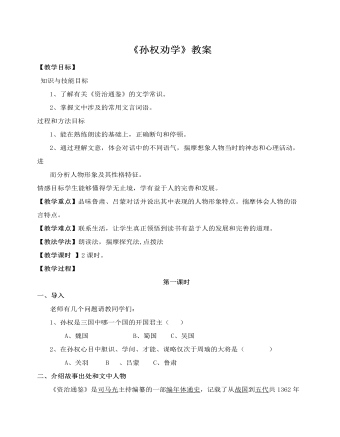
部编版语文七年级下册《孙权劝学》教案
二、介绍故事出处和文中人物《资治通鉴》是司马光主持编纂的一部编年体通史,记载了从战国到五代共1362年间的史事。司马光:字君实,陕州夏县人,北宋政治家、史学家。书名“资治”,说明本书编撰的目的是为封建统治阶级提供政治借鉴。孙权(182—252):字仲谋,吴郡富春人,三国时吴国的建立者。吕蒙:字子明,三国时吴国名将。三、朗读感知课文1、听朗读课文,注意人物对话的语气 (1)“卿今当涂掌事,不可不学!” 语重心长,谆谆告诫(2)“孤岂欲卿治经为博士邪!” (反问句,强调并不是要吕蒙研究儒家经典,当专掌经学传授的学官,而是有别的目的。)(3)“卿言多务,孰若孤?” 反问句,否定吕蒙辞以多务的理由。要重读强调(4)“卿今者才略,非复吴下阿蒙!” 感叹句,要显出惊讶不解的语气(5)“大兄何见事之晚乎!”反问句,指责中带有自豪的语气
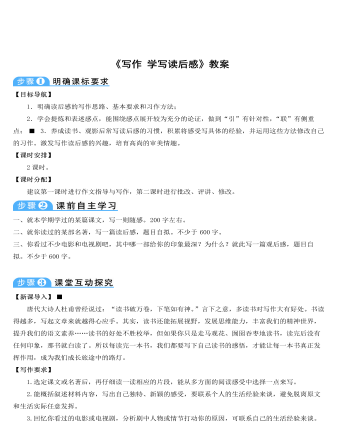
部编版语文八年级下册《写作:学写读后感》教案
【新课导入】唐代大诗人杜甫曾经说过:“读书破万卷,下笔如有神。”言下之意,多读书对写作大有好处。书读得越多,写起文章来就越得心应手。其实,读书还能拓展视野,发展思维能力,丰富我们的精神世界,提升我们的语文素养……读书的好处不胜枚举,但如果你只是走马观花、囫囵吞枣地读书,读完后没有任何印象,那书就白读了。所以每读完一本书,我们都要写下自己读书的感悟,才能让每一本书真正发挥作用,成为我们成长旅途中的路灯。【写作要求】1.选定课文或名著后,再仔细读一读相应的片段,能从多方面的阅读感受中选择一点来写。2.能概括叙述材料内容,写出自己独特、新颖的感受,要联系个人的生活经验来谈,避免脱离原文和生活实际任意发挥。3.回忆你看过的电影或电视剧,分析剧中人物或情节打动你的原因,可联系自己的生活经验来谈。【技法点拨】
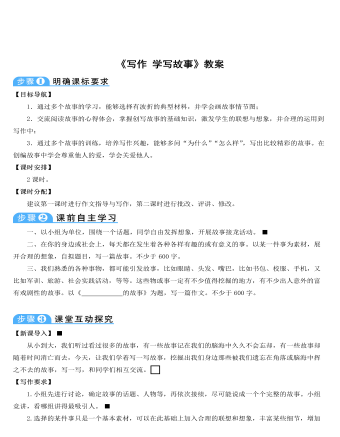
部编版语文八年级下册《写作:学写故事》教案
【目标导航】1.通过多个故事的学习,能够选择有波折的典型材料,并学会画故事情节图;2.交流阅读故事的心得体会,掌握创写故事的基础知识,激发学生的联想与想象,并合理的运用到写作中;3.通过多个故事的训练,培养写作兴趣,能够多问“为什么”“怎么样”,写出比较精彩的故事。在创编故事中学会尊重他人的爱,学会关爱他人。一、以小组为单位,围绕一个话题,同学自由发挥想象,开展故事接龙活动。二、在你的身边或社会上,每天都在发生着各种各样有趣的或有意义的事。以某一件事为素材,展开合理的想象,自拟题目,写一篇故事。不少于600字。三、我们熟悉的各种事物,都可能引发故事,比如眼睛、头发、嘴巴,比如书包、校服、手机,又比如军训、旅游、社会实践活动,等等。这些物或事一定有不少值得挖掘的地方,有不少出人意外的富有戏剧性的故事。以《 的故事》为题,写一篇作文。不少于600字。
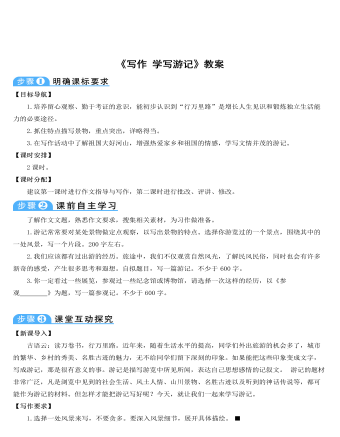
部编版语文八年级下册《写作:学写游记》教案
【目标导航】1.培养留心观察、勤于考证的意识,能初步认识到“行万里路”是增长人生见识和锻炼独立生活能力的必要途径。2.抓住特点描写景物,重点突出,详略得当。3.在写作活动中了解祖国大好河山,增强热爱家乡和祖国的情感,学写文情并茂的游记。【课时安排】2课时。【课时分配】建议第一课时进行作文指导与写作,第二课时进行批改、评讲、修改。了解作文文题,熟悉作文要求,搜集相关素材,为习作做准备。1.游记常常要对某处景物做定点观察,以写出景物的特点。选择你游览过的一个景点,围绕其中的一处风景,写一个片段。200字左右。2.我们应该都有过出游的经历。旅途中,我们不仅观赏自然风光,了解民风民俗,同时也会有许多新奇的感受,产生很多思考和遐想。自拟题目,写一篇游记。不少于600字。3.你一定看过一些展览,参观过一些纪念馆或博物馆,请选择一次这样的经历,以《参观 》为题,写一篇参观记。不少于600字。

人教版新课标高中物理必修1物理学与人类文明教案2篇
1. 课前观看视频《物理学与人类文明》2. 分组讨论,派代表发言,谈学习感受。主要是物理的地位,物理的学习方法。3. 高中物理与初中物理在内容和方法上的区别高中物理除了现象、概念和规律之外还应该关注研究问题的方法,学会从先想到抽象,从定性到定量研究问题,学会用数学方法解决物理问题,学会实验探究,学会独立分析问题解决问题的思维习惯。4. 高中物理学习的基本要求高中物理学习应该“重视实验,勤于思考”和“经历过程,体验方法”。高中物理学习与初中物理学习虽然有一定区别,但也不是孤立的,要继续坚持初中物理学习中积累的学习方法和体会,重视从正反两个方面加以总结和提炼,做到:(1) 认真阅读,学会自学要学好物理,就要认真阅读课本。阅读课本是要抓住关键词语,弄清语句间的逻辑顺序和因果关系,领会文章段落所表达的物理内容,掌握课本叙述物理问题的表达方法。

人教版新课标高中物理必修1物理学与人类文明教案2篇
八、物理学的基础地位及物理学对人类文明、社会进步的影响。(1) 情景一:磁悬浮实验:找两个空心的圆柱片磁铁,同名磁极相对,穿在同一根竹筷上,用手压下上面的磁铁,松手观察它的运动情况。问题1:上面的磁铁为什么会跳起来,为什么会悬浮在下面的磁铁上方?问题2:根据这个实验,你会想到那一种交通工具?总结:人们就是从磁悬浮现象中得到启发,进行磁悬浮列车的研究和制造的,这说明物理学在推动社会进步、人类文明方面起到推动作用。(2) 情景二:感应起电和火花放电实验:用感应起电机或感应圈产生火花放电,让学生观察现象,闻气味,然后联想生活实例。还可以用一张纸试着挡住放电的弧光,最好能引燃纸张,说明雷击引起火灾的现象。问题1:你看、听到了什么现象?问题2:根据这个实验,你会想到那一种自然现象?问题3:放电发生在什么地方?为什么建筑物上方都有尖尖的设置,是干什么用的?问题4:你闻到什么气味了吗?

人教版新目标初中英语七年级下册Where is the post office教案2篇
Period 2 (3a----Section B 2c)Preview(Pre-task): Key points: What laAdd another information about their pen pals----their language on the cardnguage does she/he speak?She/He speaks....Does she/he have any brothers and sisters? Does she/he speak English?Preview(Pre-task): Add another information about their pen pals----their language on the cardKey points: What language does she/he speak?She/He speaks....Does she/he have any brothers and sisters? Does she/he speak English?Step 1 Revision1.Revisionand dictation of the new words 2.Revise the drills they learned yesterday.(by pairwork and grammar exercise)Step 2 Leading-inT has a conversation with one student. The conversation is following:---Do you have a pen pal?---Yes, I do.---What's your pen pal's name? ---His/Her name is....---Where is your pen pal from? ---He/She is from...---Where does he/she live? ---He/She lives in....---What language does he/she speak?He/She speaks...Write the new words on the Bb. They are following: EnglishChineseJapaneseFrenchStep 3 LearnLearn the new words with the whole class.Finish 3a with the students3b Pairwork T still does an example with one student Then the Ss practise in pairs. The example is following:--Curry Muray is my pen pal. He is from the United States.---What language does he speak?

人教版新目标初中英语七年级下册Don’t eat in class教案2篇
Don’t fight. =You can’t fight. (板书,教读)教师把这些句子板书在黑板上,并请学生大声整齐地读祈使句和“can’t”句型,并让学生注意两种句型表达形式的不同和转换,“Don’t …=You can’t…”;并对学生说:These are our school rules. (板书,教读) You can’t break the school rules. Don’t break the school rules.(板书,教读)步骤3 :Practicea. T: Now, each of the students is breaking one of these rules.Please finish 1a.学生看图,完成1a的内容,检查答案并大声朗读校规。b. 听录音,完成1b,选出四位学生都违反了哪条校规;听之前,学生要读会英文名。c. 请两位学生朗读1c部分的句型;要求学生两人一组对话表演,SA扮演外校转来新生,SB告知本校校规。(学生可经过讨论,多说出他们想到的校规,不必只限于书上;教师应给予帮助)2) 第二课时(2a~4)步骤1 :warming up of revisionT: What are the rules at your school?学生使用“can”或祈使句表达各条校规;其中老师可引出“eat in the cafeteria outside”的表达。步骤2 :Practicea.T: Christina is an exchange student. She doesn’t know the rules. Let’s listen, what activities they’re talking about?学生听第一遍时,完成2a;第二遍时,完成2b;b. 请学生领读2c部分,看着2a完成的表格,理解2c活动的要求;分成小组针对2a进行问答;

人教版新目标初中英语七年级下册I want to be an actor教案2篇
三、教学建议第一课时:1. Lead in (Vocabulary)A) Before class, teacher should collect some pictures of working places. For example: Bank, TV Station, Restaurant, Police Station, Hospital ...B) In class, show students the pictures (PowerPoint, OHP). Ask students to tell the name of the working places and the name of the jobs.Shop assistant, doctor, actor, reporter, police office, waiter, bank clerk, studentC) Do exercise 1a and 3a.2. Bingo GameAsk groups of students to make up pairs of cards with a job on one and the related workplace on the other. For example, waiter / restaurant, teacher / school, doctor / hospital. Encourage students to use both the job / workplace combinations in the book and the ones that students came up during class discussions. Be sure they have twice as many sets of cards as there are students in the group. They can make two sets of cards for a single job / workplace, if necessary. Then have each group mix up its set of cards and hand their cards out in random order. Each time a student gets a pair of cards that match, he or she can lay these cards down. The goal is to have no cards in your hand at the end.3. Task OneA) Ask students to work in pairs and ask the partner what does he / she want to be in the future.e. g. :What do you / does he / does she want to be?I want to be a.Why?Because it's (adj).B) Vocabulary: Section B, 1a4. Homework 1.2.

人教版新目标初中英语七年级下册It’s raining教案2篇
1 Each group choose one place to describe and what you are doing in it Choose one place, and describe what they are doing 2 Move around the room and give suggestions Talk about it and write it down 3 Ask one to show their works and act it Choose one of each group to make a report 4 Evaluate the best group and the best reporter Choose the best one Homework Ask your friends their ideal place and write about it教学反思:新课程标准中强调学生在课堂中的主体地位,在综合课中他们的主体地位就更加突出。在各个活动中给不同程度的学生不同层次的任务,让各层面的学生都有表现发挥的机会,从而产生对英语的兴趣。使用照片图片多媒体来辅助教学,效果更好。同时让了解其他国家风景,风俗的同学介绍ideal place,增加学生的背景知知识,实现跨学科交流的目的。教案点评:采用任务型教学模式,在各个活动中给不同程度的学生不同层次的任务,让各层面的学生都有表现发挥的机会,从而产生对英语的兴趣。使用照片图片多媒体来辅助教学,效果更好。让了解其他国家风景,风俗的同学介绍ideal place,增加学生的背景知识,实现跨学科交流的目的。

人教版新目标初中英语七年级下册What do you think of game shows教案
五、教学Section B-2c1. Pair work: What do you think of the belt/sunglasses/…? What does your father/mother/… think of your scarf/belt…?2. Group work(1). Teacher shows some different kinds of school uniforms (制服)and asks : “ What do you think of your school uniforms? If you have a chance to choose your school uniforms, what kind would you like to choose?”(2). Discuss in groups.(3).Get some Ss to report in class.说明:这一步旨在让学生运用已有的语言知识谈论对事物的看法和意见,并简单阐明理由,培养学生的主动思维能力和运用英语的能力。六、教学拓展调查电视节目的收视率任务:调查你周围的人对现在各种电视节目的反响。活动过程:1.教师布置任务,让学生调查周围的人(包括他的亲戚朋友和邻居)喜欢收看哪方面的电视节目。2.学生进行调查活动,运用本单元所学的句型What do you think of….? (Why?)What's your favorite game shows?What do you think of talk show?I doesn’t mind it.I like it.I love it.I can’t stand it.3.记录下排在前10位的TV Program,填写调查表,比较其收视率。

人教版新目标初中英语七年级下册Why do you like koalas教案2篇
单元整体说明(一)单元教材分析本单元的核心话题是描述动物和表达个人喜好,以及句式why do you like…? Because…。这也是本单元的教学重点。通过本单元的学习,学生应能较流利地运用所学词汇和句型描述动物,表达个人喜好。(二)单元知识结构1.词汇动物名称 tiger, elephant, koala, dolphin, etc.词汇描述性形容词: smart, cute, ugly, clever, shy, etc.国家名: Australia, South Africa2.句型Why do you like koala hears? Because they are cute.Where are pandas from? They're from China.What animals do you like? I like dolphins.(三)单元整体目标1.Master the vocabulary2.Master and use: Why do you like koalas? Because they am cute.Where are pandas from? They're from China.What animals do you like? I like dolphins.(四)单元教学重难点一览(五)单元学情分析学生此前已经学过由why, where, what 引导的特殊疑问句句型,具有了学习本单元知识的认知前提。形形色色的动物能激发学生的好奇心,产生了解它们的欲望,这有利于本单元知识的教学和学生学习兴趣的培养。

人教版新目标初中英语八年级下册It’s a nice day, isn’t it教案2篇
"Hello! Welcome to English class! Introduce yourself. Meet your new classmates." That's what the teacher says. What do you say? "Oh no!" It can be difficult talking to new people. But it can be fun, and you can make friends. How do you do it? Make small talk. Small talk is polite conversation. "Wang Nan is a great pingpang player, isn't she?" "I'd love to meet her, wouldn't you?" "It's been raining a lot, hasn't it?" Tag questions are a form of polite speech. To make small talk successfully, you should know how to make them. You should also know what topics to talk about. Try to learn this unit carefully. The next time you're in English class, you'll find out. Making small talk's easy, isn't it? (“你好!欢迎你!请做一下自我介绍。认识一下你的新同学。”通常在课上老师会这样说。你会说什么呢?“噢,不!”与陌生人谈话太困难了。但是这也很有意思,并且你还能交到朋友。你该怎么做呢?闲聊。闲聊指得是礼貌的对话。“王楠是一个很棒的乒乓球运动员,不是吗?”“我希望自己能认识她,你呢?“今年的雨水很多,不是吗?”反意疑问句是一种礼貌用语。为了使得谈话成功,你应该知道怎样去进行闲聊。你还应该知道与不同的人该谈论什么样的话题。认真的学习这个单元吧,下次在英语课上,你会发现与大家展开谈话是一件很容易的事情,不信我们来试试。)

人教版新目标初中英语八年级下册Would you mind turning down the music教案
Step 4. Group work (4)1. Ask a pair of students to read the dialogue. Say, This activity provides speaking, listening and writing practice using the target language.2. Ask students to complete the work in groups.3. Check the answers with the whole class. 4. Explain some of the language points. Step 5. Word review (Self check 1)1. Ask students to read the words and the phrases given. 2. Fill in the blanks with proper forms of these words to complete the sentences. 3. Check the answers with the whole class. Homework:Do activity 2 on page 57 after class. Period 6Teaching aims: 1. Teach vocabulary words and the useful expressions. 2. Enable the students to learn etiquette in different culture. 3. Help the students learn how to behave politely in public places and in daily life. Teaching procedures:Step 1. RevisionHelp students to review the function of making requests through a free talk. Then lead them to the topic of etiquette. Explain the meaning of etiquette. Or, ask students to look it up in the dictionary. Step 2. Pre-reading (Section 1)1. Ask students to read the picture and make a list with their partner about how many rules of etiquette can be seen being broken.

人教版新目标初中英语七年级下册How was your weekend教案2篇
Teaching Goal:1. General aims:Talk about recent past events2. Particular aims:A. Language Focus.Talk about recent past events and think of the past events.B. Language goalsHow was….?It was …What did …do over the weekend?C. Language structures:(1). How was your weekend? I was great. Pay attention to no form.(2). What did you do over the weekend? I played soccer. We went to the beach.D. Useful words and phrases:Words: was, did, went, beach, over, project, test, wasn’t, false, number, geography, spend, week, most, mixture, their, had, little, cook, read, saw, change, everyone, sit, sat, no, anythingPhrases: did one’s homework, played soccer, cleaned my room, went to the beach, played tennis, went to the movies, on Saturday morning, over the weekend, cook … for, what about, do some reading, have a party, talk show, go shoppingE. Grammar language:Present simple past tenseRegular and irregular verbsF. Learning strategies:Tour and holidaysG. Interdiscipinary:H. Emotion and manner:Teaching time: 5 periodsTeaching procedures:Period One教学步骤、时间 教师活动 学生活动 媒体应用Step 1Free talk 3’ Ask some questions like:Who’s on duty today?What’s the weather like? Answer and talk about something.让同学们回答下列问题1. Do you like weekend? (Let some students answer)It takes them three minutes to talk about the question.2. Why do you like weekend? (let the students answer) Most of the students like the weekend此时教师用汉语问:“在周末期间问你干了什么?这句话用英语这么回答?Let the students guess.At last the teacher give them right answer3. What did you do over the weekend?(板书、学习)

